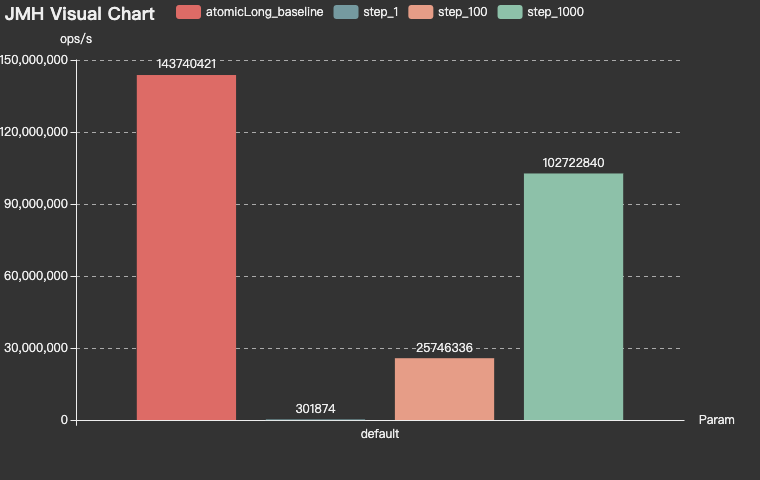内容简介:CosId 通用、灵活、高性能的分布式 ID 生成器 更新内容(1.1.8) :tada: :tada: :tada: 优化:新增抽象 IdSegmentinterface。 增强:优化 DefaultSegmentId防御性校验后端发号器持久层号段丢失、回滚。 增强:增强...
CosId 通用、灵活、高性能的分布式 ID 生成器
更新内容(1.1.8) ???? ???? ????
- 优化:新增抽象
IdSegmentinterface。
- 增强:优化
DefaultSegmentId防御性校验后端发号器持久层号段丢失、回滚。
- 增强:增强
IdSegmentDistributor支持批量获取号段,降低网络ID请求频次,进一步提升性能。
- 优化:优化 SegmentChainId (lock-free)性能,合理配置的情况下可达到 AtomicLong性能级别(10272W+/s JMH 基准测试)。

- 新增:添加 IdSegmentDistributor.Mock,模拟发号器网络IO请求,方便测试。
- 增强:支持通过 spring-boot 配置开启 SegmentChainId 模式(spring-boot-starter-cosid)。
- 新增:添加 LifecycleSegmentChainId优雅关闭 PrefetchWorker 。
介绍
IdSegmentinterface。DefaultSegmentId防御性校验后端发号器持久层号段丢失、回滚。IdSegmentDistributor支持批量获取号段,降低网络ID请求频次,进一步提升性能。
CosId 旨在提供通用、灵活、高性能的分布式 ID 生成器。 目前提供了三类 ID 生成器:
SnowflakeId: 单机 TPS 性能:409W/s JMH 基准测试 , 主要解决 时钟回拨问题 、* 机器号分配问题* 并且提供更加友好、灵活的使用体验。SegmentId:RedisIdSegmentDistributor单机 TPS 性能(步长 1000) :2950W+/s JMH 基准测试 , 每次获取一段(Step) ID,来降低号段分发器的网络IO请求频次提升性能。SegmentChainId:SegmentChainId(lock-free) 是对SegmentId的增强,设计图如下。PrefetchWorker维护安全距离(safeDistance), 使得SegmentChainId达到近似AtomicLong的 TPS 性能(步长 1000): 10272W+/s JMH 基准测试 。

SnowflakeId

SnowflakeId 使用
Long(64 bits) 位分区来生成 ID 的一种分布式 ID 算法。 通用的位分配方案为:timestamp(41 bits) +machineId(10 bits) +sequence(12 bits) = 63 bits 。
- 41 位
timestamp= (1L<<41)/(1000/3600/365) 约可以存储 69 年的时间戳,即可以使用的绝对时间为EPOCH+ 69 年,一般我们需要自定义EPOCH为产品开发时间,另外还可以通过压缩其他区域的分配位数,来增加时间戳位数来延长可用时间。 - 10 位
machineId= (1L<<10) = 1024 即相同业务可以部署 1024 个副本 (在 Kubernetes 概念里没有主从副本之分,这里直接沿用 Kubernetes 的定义) 实例,一般情况下没有必要使用这么多位,所以会根据部署规模需要重新定义。 - 12 位
sequence= (1L<<12) * 1000 = 4096000 即单机每秒可生成约 409W 的 ID,全局同业务集群可产生 4096000*1024=419430W=41.9亿(TPS)。
从 SnowflakeId 设计上可以看出:

timestamp在高位,所以 SnowflakeId 是本机单调递增的,受全局时钟同步影响 SnowflakeId 是全局趋势递增的。 SnowflakeId 不对任何第三方中间件有强依赖关系,并且性能也非常高。
SnowflakeId 不对任何第三方中间件有强依赖关系,并且性能也非常高。 位分配方案可以按照业务系统需要灵活配置,来达到最优使用效果。
位分配方案可以按照业务系统需要灵活配置,来达到最优使用效果。 强依赖本机时钟,潜在的时钟回拨问题会导致 ID 重复。
强依赖本机时钟,潜在的时钟回拨问题会导致 ID 重复。
machineId需要手动设置,实际部署时如果采用手动分配machineId,会非常低效。
CosId-SnowflakeId 主要解决 SnowflakeId 俩大问题:机器号分配问题、时钟回拨问题。 并且提供更加友好、灵活的使用体验。
MachineIdDistributor (MachineId 分配器)
目前 CosId 提供了以下三种
MachineId分配器。
ManualMachineIdDistributor
cosid: snowflake: machine: distributor: type: manual manual: machine-id: 0
手动分配
MachineId。
StatefulSetMachineIdDistributor
cosid: snowflake: machine: distributor: type: stateful_set
使用
Kubernetes的StatefulSet提供的稳定的标识 ID 作为机器号。
RedisMachineIdDistributor

cosid: snowflake: machine: distributor: type: redis
使用
Redis作为机器号的分发存储。
ClockBackwardsSynchronizer (时钟回拨同步器)
cosid: snowflake: clock-backwards: spin-threshold: 10 broken-threshold: 2000
默认提供的 DefaultClockBackwardsSynchronizer 时钟回拨同步器使用主动等待同步策略,spinThreshold(默认值 10 毫秒) 用于设置自旋等待阈值, 当大于spinThreshold 时使用线程休眠等待时钟同步,如果超过brokenThreshold(默认值 2 秒)时会直接抛出ClockTooManyBackwardsException异常。
MachineStateStorage (机器状态存储)
public class MachineState {
public static final MachineState NOT_FOUND = of(-1, -1);
private final int machineId;
private final long lastTimeStamp;
public MachineState(int machineId, long lastTimeStamp) {
this.machineId = machineId;
this.lastTimeStamp = lastTimeStamp;
}
public int getMachineId() {
return machineId;
}
public long getLastTimeStamp() {
return lastTimeStamp;
}
public static MachineState of(int machineId, long lastStamp) {
return new MachineState(machineId, lastStamp);
}
}
cosid: snowflake: machine: state-storage: local: state-location: ./cosid-machine-state/
默认提供的 LocalMachineStateStorage 本地机器状态存储,使用本地文件存储机器号、最近一次时间戳,用作 MachineState 缓存。
ClockSyncSnowflakeId (主动时钟同步 SnowflakeId)
cosid: snowflake: share: clock-sync: true
默认 SnowflakeId 当发生时钟回拨时会直接抛出 ClockBackwardsException 异常,而使用 ClockSyncSnowflakeId 会使用 ClockBackwardsSynchronizer 主动等待时钟同步来重新生成 ID,提供更加友好的使用体验。
SafeJavaScriptSnowflakeId (JavaScript 安全的 SnowflakeId)
SnowflakeId snowflakeId=SafeJavaScriptSnowflakeId.ofMillisecond(1);
JavaScript 的 Number.MAX_SAFE_INTEGER 只有 53 位,如果直接将 63 位的 SnowflakeId 返回给前端,那么会值溢出的情况,通常我们可以将SnowflakeId 转换为 String 类型或者自定义 SnowflakeId 位分配来缩短 SnowflakeId 的位数 使 ID 提供给前端时不溢出。
SnowflakeFriendlyId (可以将 SnowflakeId 解析成可读性更好的 SnowflakeIdState )
cosid: snowflake: share: friendly: true
public class SnowflakeIdState {
private final long id;
private final int machineId;
private final long sequence;
private final LocalDateTime timestamp;
/**
* {@link #timestamp}-{@link #machineId}-{@link #sequence}
*/
private final String friendlyId;
}
public interface SnowflakeFriendlyId extends SnowflakeId {
SnowflakeIdState friendlyId(long id);
SnowflakeIdState ofFriendlyId(String friendlyId);
default SnowflakeIdState friendlyId() {
long id = generate();
return friendlyId(id);
}
}
SnowflakeFriendlyId snowflakeFriendlyId=new DefaultSnowflakeFriendlyId(snowflakeId);
SnowflakeIdState idState=snowflakeFriendlyId.friendlyId();
idState.getFriendlyId(); //20210623131730192-1-0
SegmentId (号段模式)
RedisIdSegmentDistributor (使用Redis作为号段分发后端存储)
cosid: segment: enabled: true distributor: type: redis share: offset: 0 step: 100 provider: bizC: offset: 10000 step: 100 bizD: offset: 10000 step: 100
RedisIdSegmentDistributor 步长设置为 1 时(每次生成ID都需要执行一次 Redis 网络 IO 请求)TPS 性能约为 21W/s (JMH 基准测试 ),如果在部分场景下我们对 ID 生成的 TPS 性能有更高的要求,那么可以选择使用增加每次ID分发步长来降低网络 IO 请求频次,提高 IdGenerator 性能(比如增加步长为 1000,性能可提升到 3545W+/s JMH 基准测试)。
SegmentChainId (号段链模式)

cosid: segment: enabled: true mode: chain chain: safe-distance: 100 prefetch-period: 4000ns distributor: type: redis share: offset: 0 step: 100 provider: bizC: offset: 10000 step: 100 bizD: offset: 10000 step: 100
IdGeneratorProvider
cosid: snowflake: provider: bizA: # epoch: # timestamp-bit: sequence-bit: 12 bizB: # epoch: # timestamp-bit: sequence-bit: 12
IdGenerator idGenerator=idGeneratorProvider.get("bizA");
在实际使用中我们一般不会所有业务服务使用同一个 IdGenerator ,而是不同的业务使用不同的 IdGenerator,那么 IdGeneratorProvider 就是为了解决这个问题而存在的,他是 IdGenerator 的容器,可以通过业务名来获取相应的 IdGenerator。
Examples
安装
Gradle
Kotlin DSL
val cosidVersion = "1.1.8";
implementation("me.ahoo.cosid:spring-boot-starter-cosid:${cosidVersion}")
Maven
<?xml version="1.0" encoding="UTF-8"?> <project xmlns="http://maven.apache.org/POM/4.0.0" xmlns:xsi="http://www.w3.org/2001/XMLSchema-instance" xsi:schemaLocation="http://maven.apache.org/POM/4.0.0 http://maven.apache.org/xsd/maven-4.0.0.xsd"> <modelVersion>4.0.0</modelVersion> <artifactId>demo</artifactId> <properties> <cosid.version>1.1.8</cosid.version> </properties> <dependencies> <dependency> <groupId>me.ahoo.cosid</groupId> <artifactId>spring-boot-starter-cosid</artifactId> <version>${cosid.version}</version> </dependency> </dependencies> </project>
application.yaml
cosid: namespace: ${spring.application.name} snowflake: enabled: true # epoch: 1577203200000 clock-backwards: spin-threshold: 10 broken-threshold: 2000 machine: # stable: true # machine-bit: 10 # instance-id: ${HOSTNAME} distributor: type: redis # manual: # machine-id: 0 state-storage: local: state-location: ./cosid-machine-state/ share: clock-sync: true friendly: true provider: bizA: # timestamp-bit: sequence-bit: 12 bizB: # timestamp-bit: sequence-bit: 12 segment: enabled: true mode: chain chain: safe-distance: 100 prefetch-period: 4000ns distributor: type: redis share: offset: 0 step: 100 provider: bizC: offset: 10000 step: 100 bizD: offset: 10000 step: 100
JMH-Benchmark
- 基准测试运行环境:笔记本开发机 ( MacBook Pro (M1) )
- 所有基准测试都在开发笔记本上执行。
- Redis 部署环境也在该笔记本开发机上。
SnowflakeId
gradle cosid-core:jmh # or java -jar cosid-core/build/libs/cosid-core-1.1.8-jmh.jar -bm thrpt -wi 1 -rf json -f 1
Benchmark Mode Cnt Score Error Units SnowflakeIdBenchmark.millisecondSnowflakeId_friendlyId thrpt 4020311.665 ops/s SnowflakeIdBenchmark.millisecondSnowflakeId_generate thrpt 4095403.859 ops/s SnowflakeIdBenchmark.safeJsMillisecondSnowflakeId_generate thrpt 511654.048 ops/s SnowflakeIdBenchmark.safeJsSecondSnowflakeId_generate thrpt 539818.563 ops/s SnowflakeIdBenchmark.secondSnowflakeId_generate thrpt 4206843.941 ops/s
RedisIdBenchmark

gradle cosid-redis:jmh # or java -jar cosid-redis/build/libs/cosid-redis-1.1.8-jmh.jar -bm thrpt -wi 1 -rf json -f 1 RedisIdBenchmark
Benchmark Mode Cnt Score Error Units RedisIdBenchmark.step_1 thrpt 5 207470.850 ± 11832.936 ops/s RedisIdBenchmark.step_100 thrpt 5 3868126.197 ± 258008.896 ops/s RedisIdBenchmark.step_1000 thrpt 5 29506073.112 ± 2502253.182 ops/s
RedisChainIdBenchmark

gradle cosid-redis:jmh # or java -jar cosid-redis/build/libs/cosid-redis-1.1.8-jmh.jar -bm thrpt -wi 1 -rf json -f 1 RedisChainIdBenchmark
Benchmark Mode Cnt Score Error Units RedisChainIdBenchmark.atomicLong_baseline thrpt 5 143740421.831 ± 1142477.957 ops/s RedisChainIdBenchmark.step_1 thrpt 5 301874.926 ± 10340.941 ops/s RedisChainIdBenchmark.step_100 thrpt 5 25746336.165 ± 433565.840 ops/s RedisChainIdBenchmark.step_1000 thrpt 5 102722840.616 ± 2368562.637 ops/s
RedisIdBenchmark VS RedisChainIdBenchmark TPS (ops/s)

RedisIdBenchmark VS RedisChainIdBenchmark Sample (us/op)

java -jar cosid-redis/build/libs/cosid-redis-1.1.8-jmh.jar -bm sample -wi 1 -rf json -f 1 -tu us step_1000
Benchmark Mode Cnt Score Error Units RedisChainIdBenchmark.step_1000 sample 1062954 0.056 ± 0.002 us/op RedisChainIdBenchmark.step_1000:step_1000·p0.00 sample ≈ 0 us/op RedisChainIdBenchmark.step_1000:step_1000·p0.50 sample 0.042 us/op RedisChainIdBenchmark.step_1000:step_1000·p0.90 sample 0.083 us/op RedisChainIdBenchmark.step_1000:step_1000·p0.95 sample 0.084 us/op RedisChainIdBenchmark.step_1000:step_1000·p0.99 sample 0.125 us/op RedisChainIdBenchmark.step_1000:step_1000·p0.999 sample 3.000 us/op RedisChainIdBenchmark.step_1000:step_1000·p0.9999 sample 8.818 us/op RedisChainIdBenchmark.step_1000:step_1000·p1.00 sample 290.304 us/op RedisIdBenchmark.step_1000 sample 1374946 0.064 ± 0.003 us/op RedisIdBenchmark.step_1000:step_1000·p0.00 sample ≈ 0 us/op RedisIdBenchmark.step_1000:step_1000·p0.50 sample 0.042 us/op RedisIdBenchmark.step_1000:step_1000·p0.90 sample 0.042 us/op RedisIdBenchmark.step_1000:step_1000·p0.95 sample 0.042 us/op RedisIdBenchmark.step_1000:step_1000·p0.99 sample 0.083 us/op RedisIdBenchmark.step_1000:step_1000·p0.999 sample 0.291 us/op RedisIdBenchmark.step_1000:step_1000·p0.9999 sample 46.624 us/op RedisIdBenchmark.step_1000:step_1000·p1.00 sample 483.840 us/op
以上就是本文的全部内容,希望本文的内容对大家的学习或者工作能带来一定的帮助,也希望大家多多支持 码农网
猜你喜欢:本站部分资源来源于网络,本站转载出于传递更多信息之目的,版权归原作者或者来源机构所有,如转载稿涉及版权问题,请联系我们。
Linux内核设计与实现(原书第3版)
Robert Love / 陈莉君、康华 / 机械工业出版社华章公司 / 2011-4-30 / 69.00元
《Linux内核设计与实现(原书第3版)》详细描述了Linux内核的设计与实现。内核代码的编写者、开发者以及程序开发人员都可以通过阅读本书受益,他们可以更好理解操作系统原理,并将其应用在自己的编码中以提高效率和生产率。 《Linux内核设计与实现(原书第3版)》详细描述了Linux内核的主要子系统和特点,包括Linux内核的设计、实现和接口。从理论到实践涵盖了Linux内核的方方面面,可以满......一起来看看 《Linux内核设计与实现(原书第3版)》 这本书的介绍吧!





